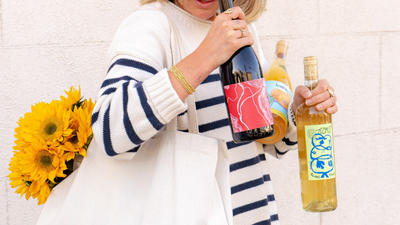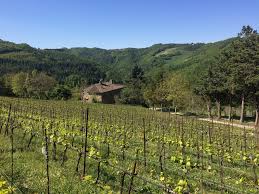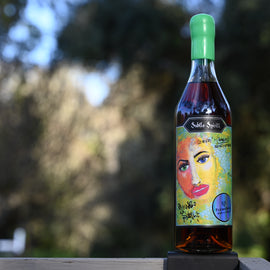Emilia-Romagna
Tuscany may draw more tourists, but Emilia-Romagna, its neighbor to the north, mounts a mosaic of Italian cultural splendor everywhere you look. Stretching across north-central Italy, from the southeastern tip of Piedmont to the Adriatic Sea, the nine provinces that make up the region flaunt apogees in everything from cars (Ducati, Lamborghini, Ferrari, Maserati, and Pagani all rev their engines here); to cinema (Antonioni, Bertolucci, Pasolini, and Fellini are native sons; the latter’s immortal Amacord was filmed in his childhood home of Rimini on the Adriatic); to music (composers Verdi and Toscanini hail from the small town of Busseto and the City of Parma, respectively); to, of course, mosaics (the stunning early Christian art of one time Roman Empire capital Ravenna).
It’s an amazing place to venerate the heights of human craft and creativity - and then go eat, because Emilia Romagana is also the food capital of Italy. Parma, the region’s second largest city is the birthplace of both Parmesan Reggiano and Prosciutto di Parma; Bologna, the actual capital and largest city - which also houses the world’s oldest university - gifts the world ragù (bolognese sauce) and tagliatelle. Modena, hometown of the tenor Pavoratti, is also responsible for balsamic vinaigrette in its most elevated form. Nor is the region simply coasting on its culinary past – Osteria Francescana in Modena, topped the ‘World 50 Best Restaurants’ list in 2016 and 2018 - and there are countless exceptional places to eat that are less famous and easier to get into.
The wine is great too of course, though sometimes it gets eclipsed by all the blinding nearby excellence. Viticulture in Emilia-Romagna is quite regionally specific and has developed roughly along the bifurcation traced by its hyphen. Emilia, the western part, which consists of the provinces of Piacenza, Parma, Regio Emilia, Modena, and Ferrara, was settled by Germanic populations, whose rich diet of butter and pork called for the palate cleansing properties of sparkling wine. Consequently, this is where Lambrusco, the frizzante red that is the region’s best known (and one of Italy’s oldest) wines, comes from. Romagna, made up of Ravenna, Forlì-Cesena, and Rimini in the east, was ruled by Romans and olive oil whose herb-y, oleaginous effect requires wine with more structure to balance the flavors in the mouth. Romagna is best known for the thick-skinned white grape Albana, whose roots in the region go back to antiquity (Albus = white in Latin) and is rarely seen outside it; and Sangiovese di Romagna, the local variation on the iconic red grape best known for Tuscan bottlings like Chianti and Brunello.
Both of our wines this month hail from the aforementioned Forli-Cesena sub-hyphen, in the southeastern part of the province. The white is made on a historic (see below for details) estate called Pandolfa, just outside the town of Predappio at the foot of the Tuscan-Romagnolo Appeninies. The grape is Trebbiano Romagnolo, similar to but distinct from Trebbiano Toscana, which is one of the most widely planted varietals in the world. Both versions are generally uncelebrated, but there are a handful of vintners out there, Noelia Ricci very much one, working sustainably with old vines and lees aging in the cellar, that turn Trebbiano into something worth talking about.
The red, in contrast, comes from a grape so rare and specific, its name, Centesimino (Italian for ‘cheapskate’) is derived from the nickname of Pietro Pianori, the farmer responsible for preserving its cultivation. We can only assume the sobriquet was bestowed affectionately and with a hint of mischief, because Centesimo is quite generous; coming from some of the world’s very few remaining ungrafted vinifera vines, it is a semi-aromatic, dark ruby red wine roughly comparable to Grenache, but with a savory wildness distinctively its own.
Salut,
Alan Hicks - Wine Buyer - Noe Valley
|
Noelia Ricci Trebbiano ‘Bro’ 2020 |
|
|
Region: Romagna Trebbiano DOC, Italy |
About the Winery: Noelia Ricci is a project born in 2010 on an estate called Pandolfa which extends over 140 hectares in Predappio. The property’s name is believed to have been chosen because Sigismondo Pandolfo Malatesta, known as the “Lupo di Rimini”, lived here before setting out to sack the Castle of Fiumana in 1436. From 1626 to 1941 the owners of the estate were the Marquis Albicini. In 1941 the property passed to Commendatore (Knight Commander) Giuseppe Ricci, an entrepreneur from Forlì. During the Second World War, the Pandolfa estate found itself at the center of the tragic events of the war. It was occupied by the Germans and then attacked by Polish troops, while many of the locals took refuge in its cellars. Once peace returned, in the 1950s, Giuseppe Ricci began the renovation of the estate, involving well-known local artists, who created works of art that match the heritage of this area. Ricci also began to rethink agricultural production, which had been of great importance during the period of the Albicini, and bought two adjacent farms and planted Sangiovese, Trebbiano and Albana vines. On Ricci’s death in 1980, his daughter Noelia, from whom the entire project takes its name, was the first to understand the potential of the original estate’s slopes. Driven by this strong vision, she began to plant new vineyards and to start construction of the winemaking cellar. Pandolfa is still owned by Ricci’s granddaughter, Paola Piscopo, who has used all her enthusiasm to give the Estate an important role in the territory. Today one of her sons, Marco Cirese, has taken the reins of the operation with the intention of continuing on the path to excellence with an eye to the tradition of this place and the native vines of Romagna. About the Winemaking: Yellow clay soil with limestone and Sulphur minerals. Hand-picking, in the first week of September. Fermentation of Trebbiano must with a 4-month maceration with a little quote of skins. The fermentation takes place in stainless steel temperature-controlled tank followed by 6 months on lees in stainless steel tanks and minimum 2 months in bottle. Tasting Notes: A bouquet of lemon zest, citrus, petrol, and floral notes. Aromas mirror flavors on this dry and balanced palate with hints of minerality from clay and limestone soils. Aged 4 months on lees. |
|
Winemaker: Mario Cirese |
|
|
Price per bottle / Price per case $27.99 $302.30 |
|
|
Suggested Food Pairing: Antipasti, salads, grilled/fried fish, poached fish, vegetable meals, caviar, seafood/shellfish, asparagus |
|
|
Villa Papiano Centesimino Forli IGT |
|
|
Region: Modigliana, Romagna |
About the Winery: Villa Papiano is a gorgeous, breathtaking place. Nestled amid the pristine, densely forested hills of Modigliana (Romagna) at over 1900 feet, its organically farmed vineyards are planted on ancient sandstone of marine origin, yielding savory, bright and juicy wines. Though the vines were planted in the 1960’s, the winery took its current form in 2001, when agronomist, winemaker and agricultural engineering PhD Franceso Bordindi bought the property with his 3 siblings with the goal of making outstanding high altitude Sangiovese di Romagna. Consulting winemaker for 15 other estates in the appellation, he’s acknowledged as perhaps the foremost expert on Romagna wines. All Villa Papiano wines are single vineyard, certified organic, and fermented with all indigenous yeasts. About Winemaking: First year of production: 2001. Soil: sandstone with intrusions of clay; 480 mt asl. Vineyard: planted in 1980 and 2001 Fermentation: with native yeasts in temp-controlled stainless steel vats; Maceration: minimum 30 days, malolactic in wooden barrels. Aging: 12 months in French barriques (40% new) and 18 months in bottle Tasting Notes: Presents an earthy aroma with cool undertones, reminiscent of a forest floor. It also has a minerality that is robust and fruity, with notes of balsamic and old-fashioned cherry jam, cand fruits and fresh red berries. The Centesimino grape variety is truly capable of producing a truly unique and complex wine that showcases its rich history and potential. |
|
Winemaker: Francesco Bordini |
|
|
Price per bottle / Price per case $33.99 $367.10 |
|
|
Suggested Food Pairing: Mushroom risotto, Beef and black bean stir-fry, Beef empanadas |
|
Passatelli with Vegetable Ragu
Passatelli are a unique kind of pasta originally from Romagna. They derive their unique form and taste from the fact that they are made from breadcrumbs and cheese instead of flour. Originally, the dough was shaped using a special implement called a ferro per passatelli, but today most people use a potato ricer. You need to choose one with large holes, of about 4mm in diameter. Passatelli are still little known outside Romagna and so this dish gives you a real taste of Italian regional cooking.
Ingredients
|
Passatelli |
Vegetable Ragu |
|
|
5 1/3 oz of white breadcrumbs 5 1/3 oz of Parmesan, freshly grated 1/8 oz of nutmeg 3 large eggs 1 1/16 oz cream cheese 12 2/3 pints of water 1 tsp salt |
1 onion, finely chopped1 eggplant diced2 zucchini diced20 cherry tomatoes, halved6 3/4 fl oz of dry white wine6 basil leavesolive oil, as needed |
-
Instructions:
- Begin by making the passatelli. Place the breadcrumbs, Parmigiano Reggiano and nutmeg in a large mixing bowl. Stir with a wooden spoon until all of the ingredients are combined
- Make a well in the middle of the breadcrumb mixture and add the eggs and cream cheese. Stir with a wooden spoon until the mixture begins to come together, then form into a ball with your hands. Leave the dough to rest for at least 1 hour
- Pass the dough through a potato ricer to form the passatelli
- Leave the passatelli to dry for about 30 minutes while you make the sauce.
- Cover the bottom of a large frying pan with olive oil. Heat gently, add the onion and cook until softened, for about 2 minutes
- Add the eggplant and cook on a low heat for about 10 minutes, stirring occasionally. Stir in the zucchini and salt and cook for a further 10 minutes
- Add the tomatoes and white wine, bring to the boil and simmer for 5 minutes. Once the vegetables are cooked, tear the basil leaves and stir through the sauce
- Bring 6 litres of water with 1 teaspoon of salt to the boil. Gently drop the passatelli into the boiling water. Cook until they float to the top, for about 2 minutes, then drain





